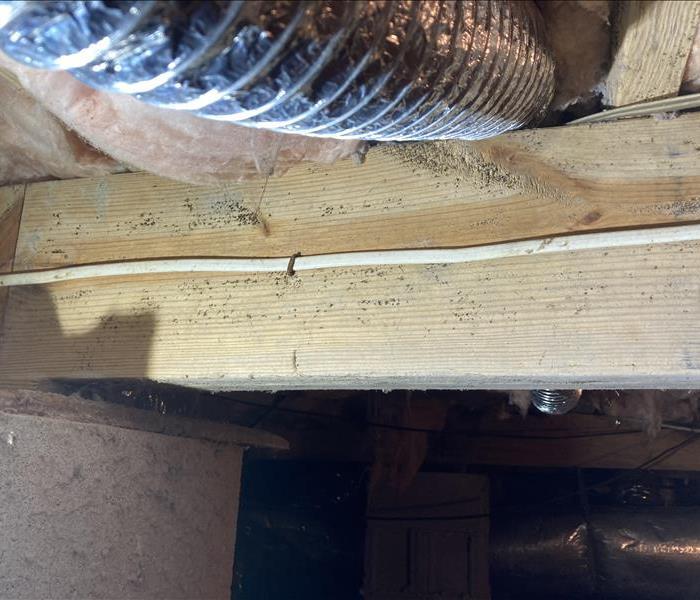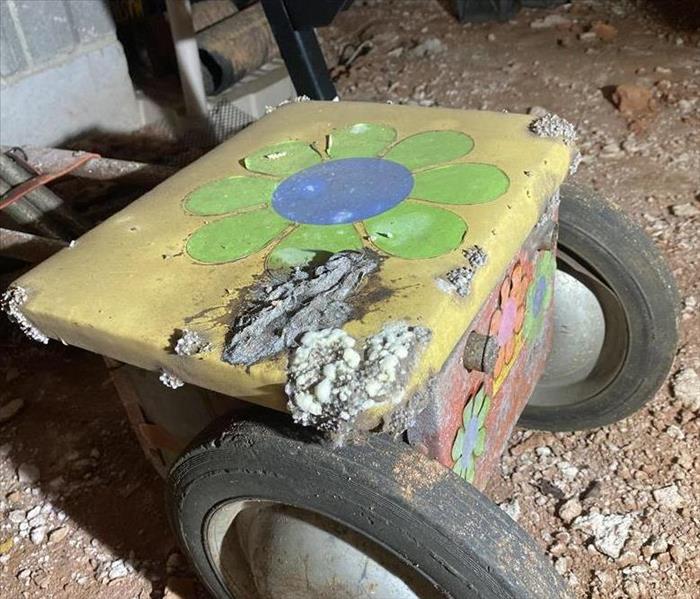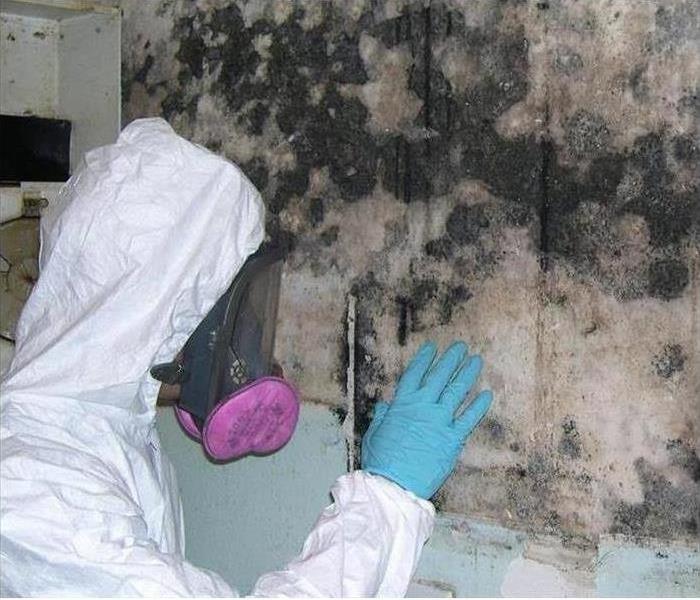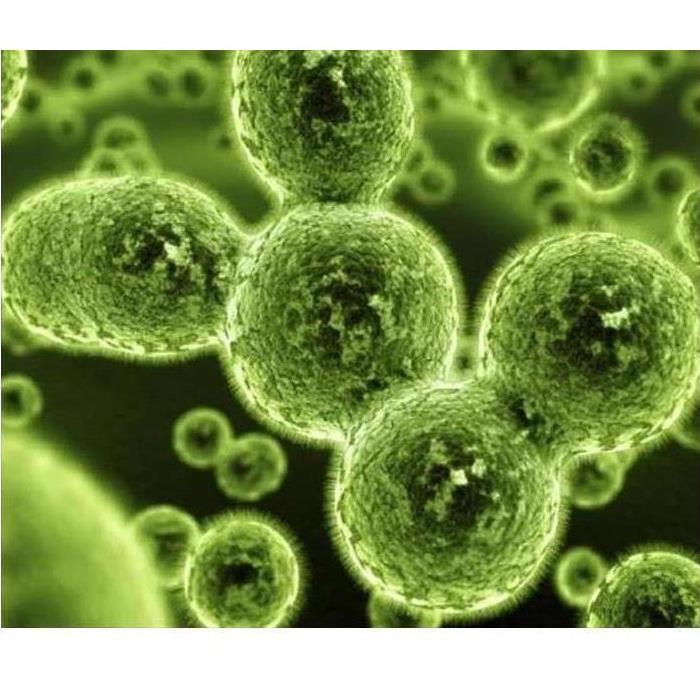Recent Mold Remediation Posts
Mold Removal and Remediation
9/5/2022 (Permalink)
Any home or business can quickly become infested with mold with the introduction of a water source, like a roof or plumbing leak. Mold can spread throughout a property in as little as 48-72 hours, and can produce allergens and irritants that have the potential to cause other health effects.
If you suspect that your home or business has a mold problem, SERVPRO can inspect and assess your property. If mold is found, they have the training, equipment, and expertise to handle the situation.
SERVPRO of Oconee/South Anderson/Pickens Counties
- Provide 24/7 Emergency Service
- Highly Trained Water Restoration Specialists
- Faster to Any Size Disaster
- A Trusted Leader in the Restoration Industry with over 1,700 Franchises
If You See Signs of Mold, Call SERVPRO!
Understanding Mold
Microscopic mold spores exist almost everywhere, outdoors and indoors, making it impossible to remove all mold from a home or business. Some restoration businesses advertise “mold removal” and even guarantee to remove all mold, which is a fallacy. Consider the following mold facts:
- Mold is present almost everywhere, indoors and outdoors.
- Mold spores are microscopic and float along in the air, and may enter your home through windows, doors, or AC/heating systems or even hitch a ride indoors on your clothing or on a pet.
- Mold spores thrive on moisture. Mold spores can quickly grow into colonies when exposed to water.
- Before mold remediation can begin, any sources of water or moisture must be addressed. Otherwise, the mold may return.
- Mold often produces a strong, musty odor and can lead you to possible mold problem areas.
- Even higher-than-normal indoor humidity can support mold growth. Keep indoor humidity below 45 percent.
Common Mold Misconception
With sensational news stories and misleading advertising, you can easily understand why so many people are misinformed about indoor mold. Learn the facts about mold and the mold remediation process.
What are the 5 MOST TOXIC TYPES of MOLD?
8/22/2022 (Permalink)
Ascospores are prominent in nature commonly found in the outdoor environment. Some fungi that belong to the Ascomycete family include the sexual forms of Penicillium/Aspergillus, Chaetominum, etc that may be frequently found growing on damp substrates.
Chaetomium are found on a variety of substrates containing cellulose including paper and plant compost. Several species have been reported to play a major role in the decomposition of cellulose-made materials. These fungi are able to dissolve the cellulose fibers in cotton and paper and thus cause the materials to disintegrate. The process is especially rapid under moist conditions. Their Ascospores are brown or gray with one or two germ pores.
Fusarium is a hydrophilic mold that requires very wet conditions and is frequently isolated from plants and grains. They colonize in continuously damp materials such as damp wallboard and water reservoirs for humidifiers and drip pans. While Fusarium Keratitis can be a serious infection, it is a rare disease. Fusarium is commonly found in organic matter such as soil and plants. This infection cannot be transmitted from person to person.
Aspergillus and Penecillium are both types of mold are ubiquitous in the environment. Aspergillus tends to colonize continuously damp materials such as damp wallboard and fabrics. Penicillium is commonly found in house dust, wallpaper, decaying fabrics, moist clipboards, etc.
Stachybotrys is the bad boy of them all
Stachybotrys, commonly called "stachy," is a greenish-black, slimy mold found only on cellulose products (such as wood or paper) that have been wet for several days or more. The mold does not grow on concrete, linoleum or tile. Stachybotrys and some other fungi may produce several toxic chemicals called mycotoxins. Mycotoxins can be present in spores and small mold fragments released into the air. Once the mold fragments, mycotoxins and spores are in the air, individuals may breathe them into their lungs.
Call SERVPRO of Oconee/South Anderson/Pickens Counties for all of your Mold Mitigation needs!
Mold Behind Wallpaper
8/22/2022 (Permalink)
Mold behind wallpaper is a big health concern. To get rid of the mold you must remove the wallpaper. First and foremost remove the wallpaper safely by wetting it with a wetting agent and water. But first wear a good cartridge-type respirator.
When removing mold behind wallpaper safely wet it first. Even if the wallpaper removes dry still wet it
A simple dust or particulate mask won't offer adequate protection. Also wear gloves and goggles, remember safety first. In a garden type sprayer add the wetting agent and water for easy application.
Using the sprayer to wet the wallpaper down will reduce the mold spores from becoming airborne. Even if the wallpaper removes dry still wet it first. Move slowly and deliberately so you don't stir up spores as you work.
Once the wallpaper is removed from the walls the next step is to wash the walls down with a water and bleach solution. This should remove the mold from the walls if it is just surface mold. If the walls are soft and spongy the mold may have penetrated deeper into the wall.
One way to tell if the walls are totally saturated with mold you can take a utility knife and cut a small square out of the wall and look at the back side of the square. If there is mold behind the wall then you should replace the walls. If you plan on wallpapering again use a Nonwoven wallpaper so you will never get mold behind wallpaper again. Nonwoven wallpapers can breath unlike vinyl wallpapers.
For Mold Mitigation Needs, call SERVPRO of Oconee/South Anderson/Pickens Counties!
Basic Mold Facts
8/22/2022 (Permalink)
What are molds?
Molds are fungi that can be found both indoors and outdoors. No one knows how many species of fungi exist but estimates range from tens of thousands to perhaps three hundred thousand or more. Molds grow best in warm, damp, and humid conditions, and spread and reproduce by making spores. Mold spores can survive harsh environmental conditions, such as dry conditions, that do not support normal mold growth.
What are some of the common indoor molds?
- Cladosporium
- Penicillium
- Alternaria
- Aspergillus
Where are molds found?
Molds are found in virtually every environment and can be detected, both indoors and outdoors, year round. Mold growth is encouraged by warm and humid conditions. Outdoors they can be found in shady, damp areas or places where leaves or other vegetation is decomposing. Indoors they can be found where humidity levels are high, such as basements or showers.
How can people decrease mold exposure?
Sensitive individuals should avoid areas that are likely to have mold, such as compost piles, cut grass, and wooded areas. Inside homes, mold growth can be slowed by controlling humidity levels and ventilating showers and cooking areas. If there is mold growth in your home, you should clean up the mold and fix the water problem. Mold growth can be removed from hard surfaces with commercial products, soap and water, or a bleach solution of no more than 1 cup of household laundry bleach in 1 gallon of water. Follow the manufacturers’ instructions for use (see product label).
If you choose to use bleach to clean up mold:
- Never mix bleach with ammonia or other household cleaners. Mixing bleach with ammonia or other cleaning products will produce dangerous, toxic fumes.
- Open windows and doors to provide fresh air.
- Wear rubber boots, rubber gloves, and goggles during cleanup of affected area.
- If the area to be cleaned is more than 10 square feet, consult the U.S. Environmental Protection Agency (EPA) guide titled Mold Remediation in Schools and Commercial Buildings.
- Always follow the manufacturer’s instructions when using bleach or any other cleaning product.
Specific Recommendations:
- Keep humidity levels as low as you can—no higher than 50%–all day long. An air conditioner or dehumidifier will help you keep the level low. Bear in mind that humidity levels change over the course of a day with changes in the moisture in the air and the air temperature, so you will need to check the humidity levels more than once a day.
- Use an air conditioner or a dehumidifier during humid months.
- Be sure the home has adequate ventilation, including exhaust fans.
- Add mold inhibitors to paints before application.
- Clean bathrooms with mold killing products.
- Do not carpet bathrooms and basements.
- Remove or replace previously soaked carpets and upholstery.
What areas have high mold exposures?
- Antique shops
- Greenhouses
- Saunas
- Farms
- Mills
- Construction areas
- Flower shops
- Summer cottages
I found mold growing in my home, how do I test the mold?
Generally, it is not necessary to identify the species of mold growing in a residence, and CDC does not recommend routine sampling for molds. Current evidence indicates that allergies are the type of diseases most often associated with molds. Since the susceptibility of individuals can vary greatly either because of the amount or type of mold, sampling and culturing are not reliable in determining your health risk. If you are susceptible to mold and mold is seen or smelled, there is a potential health risk; therefore, no matter what type of mold is present, you should arrange for its removal.
A qualified environmental lab took samples of the mold in my home and gave me the results. Can CDC interpret these results?
Standards for judging what is an acceptable, tolerable, or normal quantity of mold have not been established. If you do decide to pay for environmental sampling for molds, before the work starts, you should ask the consultants who will do the work to establish criteria for interpreting the test results. They should tell you in advance what they will do or what recommendations they will make based on the sampling results. The results of samples taken in your unique situation cannot be interpreted without physical inspection of the contaminated area or without considering the building’s characteristics and the factors that led to the present condition.
Call SERVPRO of Oconee/South Anderson/Pickens Counties for all of your Mold Mitigation needs!
8 Bad "Facts" About Mold That Most People Think Are True
8/22/2022 (Permalink)
With all the misinformation about mold out there it is easy to over react. Here are four “facts” that are over reactions to mold.
Bad “Fact” 1: All Mold Is Bad
Nope! Have you ever eaten blue cheese or take penicillin? Mold is used in the making this kind of cheese and medicine.
Bad “Fact” 2: All Mold Causes Health Problems
In reality, the effect of mold on people varies greatly. Molds produce allergens, and while some people will be allergic to the allergens produced by mold not everyone will react to mold, and the effects can be varied depending on ones’ sensitivity to mold
People who are highly sensitive to mold may develop allergic reactions and show symptoms such as difficulty breathing, bloody noses, itchy and watery eyes, etc. People with already compromised immune symptoms are also at risk for reacting to mold, and some studies have suggested that serious health effects can arise from repeated exposure to mold, so it is not something to play around with.
Bad “Fact” 3: There Should be No Mold Inside
In reality mold is all around us and is very natural. There are mold spores in the air you are breathing and there is really no way around this unless you decide to live inside a plastic, environmentally controlled bubble. The problem is not that there is mold indoors the problem is with the concentration of mold indoors. Mold should not be growing in your walls or on surfaces as that can be a problem and contribute to allergic reactions.
We will always live with mold, the question is how much mold should we live with? The answer to that is still being worked out. As mold affects people differently you should talk to your doctor if you think you are suffering from exposure to mold and you take steps to reduce your exposure to mold..
Bad “Fact” 4: Bleach Kills Mold
This is kind of a half truth. Bleach may kill certain kinds of mold on non-porous surfaces, however, it is not clear that bleach can kill all kinds of mold nor kill mold on porous surfaces such as wood. Research is continuing to be done on the effectiveness of bleach as a mold cleanup agent. It should be noted that using bleach to “kill” mold poses its own health risks and is not a recommended solution by EPA or OSHA. Bleach is also very corrosive and can cause further damage if not used correctly.
Bad “Fact” 5: Killing Mold is Enough, I Don’t Need to Remove it
Killing mold is not enough. Putting aside the conflicting reports on what kills mold, simply killing mold does not remove the health effects as the allergens are still present even in dead mold. To properly protect against health effects, removal of the affected areas is often necessary. Care must be taken when removing the affected areas so that the allergens and mold is not spread throughout the house. That is why professional mold remediation services are often necessary to properly fix a mold problem.
Bad “Fact” 6: Mold is Natural, You Shouldn’t Worry About it
While mold may be natural, consistent exposure to mold can have negative affects on ones health. If mold is growing in your home or place of business it needs to be addressed as it will deteriorate your building and can cause health problems.
Bad “Fact” 7: If You Only See a Little Mold it is Probably Nothing to Worry About
If mold is to the point where it is visibly growing on surfaces in your home you have a problem. Mold is like an iceberg, you generally only see the tip of it while the majority is below the surface. If you see a little bit of mold you most likely have more growing under the surface out of site.
Bad “Fact” 8: Cleaning up Mold isn’t Hard. You Should Do it Yourself
This is another half truth. While you may be able to clean up certain kinds of mold in small quantities most people are not equipped to do proper mold remediation. Simply wiping down the evidence is not good enough. To properly “cleanup” a mold problem you must identify the cause, isolate the area to keep the mold from spreading, and clean and or remove the affected surfaces. Unless you know how to setup a containment unit, have a couple of commercial sized HEPA air filtration units, protective gear, HEPA vacuums, specialized cleaning agents, and can do a wet extraction to keep mold spores from spreading.
Call SERVPRO of Oconee/South Anderson/Pickens Counties for your Mold Mitigation needs!
Dealing with Mold
2/8/2021 (Permalink)
 Crawlspace with Mold
Crawlspace with Mold
When there is water in your home, mold can quickly become an issue. It can cause health effects and damage to your property. SERVPRO of Oconee and South Anderson Counties has the training, protective gear, and specialized equipment to handle your mold problem.
Call SERVPRO of Oconee and South Anderson Counties
The mold cleanup and restoration process begins when you call us. One of our employees will ask a series of questions to help determine the necessary equipment, resources, and personnel needed.
Assessment
Your property will be carefully inspected for signs of mold using various technologies to detect mold and hidden water sources. Mold feeds on cellulose and water and can be hidden from plain view.
Containment
Different containment procedures will be placed to prevent the spread of mold, like negative air chambers to isolate the contaminated area with physical barriers and negative air pressure to keep the mold spores from spreading during the cleanup process.
Air Filtration
Specialized filtration equipment captures microscopic mold spores out of the air. SERVPRO of Oconee and South Anderson Counties technicians use powerful air scrubbers and HEPA vacuums to prevent the spread of these mold spores while the mold remediation is in progress.
Removing
The process of mold remediation depends on the amount of mold growth and the type of surface it's on. Anti-fungal and antimicrobial treatments will be used to eliminate mold colonies and help prevent new ones from forming. Removing and disposing of mold-infested porous materials, like drywall and flooring, may be necessary.
Cleaning
SERVPRO of Oconee and South Anderson Counties cleans your furniture, decorative items, curtains, and other restorable items affected by mold. We use a variety of cleaning techniques to clean and sanitize your belongings.
Restoration
Depending on the level of mold damage, some building materials may have to be removed. Restoration may involve minor repairs or major repairs such as reconstruction.
Mold Damage Tips
11/11/2020 (Permalink)
 Dont let mold take your personal belongings
Dont let mold take your personal belongings
Mold could be lurking in your home and you wouldn't even realize it. When mold is disturbed, it can release microscopic mold spores. When this happens mold can circulate inside your home using your HVAC system and any fans you have on. This makes it so the affected areas grow and become larger. Whether you can see it or not, here are some tips on what to do!
What Should You Do:
- Stay out of affected areas.
- Turn off the HVAC system and ALL fans.
- Contact SERVPRO of Oconee/South Anderson for mold remediation services.
What Should You Not Do:
- Don’t touch or disturb the mold.
- Don’t blow air across any surfaces with visible or suspected mold growth.
- Don’t attempt to dry the area yourself.
- Don’t spray bleach or other disinfectants on the mold
Call SERVPRO of Oconee/South Anderson today for your mold remediation needs.
864-916-4160





 24/7 Emergency Service
24/7 Emergency Service



